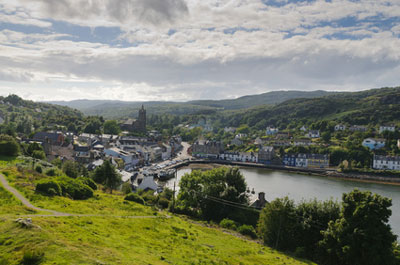David DeSmith: I would like to say hello to Jimmy Kidd. Good morning, Jimmy.
Jimmy Kidd: Good morning to you, David. Good afternoon, I should say.
David: That’s right. I should point out that I am calling from the east coast of the US, and Jimmy is over in Machrihanish, where it’s afternoon, and you mentioned that it’s not the sunniest of days.
Jimmy: It’s a very typical sort of spring day here, with [fog] coming off the ocean with a little bit of a chill in the wind at the same time. But it’s healthy, as they say.
David: [laughs] Very nice. Perfect golf weather, in other words.
Jimmy: Yeah, typical Scottish golf weather, David.
[laughs]
David: Jimmy, you have been involved in the golf business for many, many years. How did you get started with the game of golf?

Jimmy: I’m 69, and I came into golf at the age of 15 and a half from a farming background. I’m the oldest of sevenScenic landscape of Tarbert Loch Fyne in Kintyre children. I was relatively clever in high school. My family wanted me out of farming and decided they would put me into a scientific area, a laboratory. Would you believe, in the leatherworks?
After six months, I realized that that’s not where I wanted to spend my life. In the ‘60s, when I got my first apprenticeship at Ranfurly Castle Golf Club, I realized that I was forever destined to work in the great outdoors with the freedom and the natural aspects of the environment, which have always enthralled me.
That’s basically why I came into the game. That’s when I came into the game, the early ‘60s. Golf was blooming in those days, David. Gleneagles, in those days, were doing 100,000 to 117,000 runs a year on three golf courses. I thought to myself, “Coming into this business as a superintendent with some brains, I could really progress through the ranks.” That’s exactly what’s happened to me.
David: Progress you did, culminating in the position that you held for a long, long time at Gleneagles.
Jimmy: Yeah, I had 22 or nearly 23 good years at Gleneagles. I hosted and coordinated, set up the golf courses on the estates for 17 major European tour events, including eight consecutive Bell’s Scottish Open Championships, four Johnny Walkers, I think I had four McDonald World Match Play Invitationals for the LPGA.
I had a Dunhill Cup, and many other special events. Plus, I was actively involved as the estates director in setting up the shooting schools for Jackie Stewart, and the equestrian school for Captain Phillips.
I suppose the highlight of my life was the coordination for the bid for the Rider Cup in 2014 with a small team of people, which was successful and, of course, culminates in September this year over the PGA Centenary Course. Which was, of course, the Monarch’s Course.
I was client representative on that project, working with Nicholas, for four years. Two years in planning and two years in construction. Then we had two final years in grow in.
It takes about four years in this part of the world here, from construction start to first day play, because our seasons are so short. To get any kind of maturity on the new grasses on golf courses here takes at least two seasons. It was a wonderful time. I thoroughly enjoyed it.
When the bid was successful in 2002, I decided it was time to move on from there after those 22, 23 successful years. I was offered a position at Sandy Lane Resort in Barbados as general manager of golf and properties. I hosted a world cup event there, and also grew in two courses, the Green Monkey, and the country club. Very interesting times.
David: You also hosted another fairly interesting event down at Sandy Lanes, as I recall, being the marriage of Tiger Woods.
Jimmy: I married Tiger Woods. I tell everyone that. I married Tiger Woods. I remember the honorable Mister Dermot Desmond coming to me and saying he had a very grand affair coming up, and he wouldn’t tell me what it was.
Being in control of all of golf, the club house and the properties, such like, I was destined to set up the club house for a wedding, he said, at 5:20 on a Tuesday afternoon with the setting being the Caribbean ocean and the sunset.
A couple of weeks before it, he divulged it would be Tiger Woods. We had Tiger there with his beautiful wife and her twin sister. We gave them all 111 bedrooms for free for his guests, a yacht on the ocean. It was a spectacular time. There were very few reports of it. I don’t think a photograph of it ever appeared in the press anywhere. It was so secret.
David: Yeah, you did a good job on the security there.
Jimmy: Yeah. It was good fun.
David: I bet it was. It’s one thing to be overseeing one golf course, but obviously at Gleneagles, you had three. The King’s, the Queen’s, and the Monarch’s, now the PGA Centenary course. What kind of staff did you have behind you to manage all of those golf holes?
Jimmy: Well, I actually had four, David. We had King’s and Queen’s. We had the Prince’s course, and we had the Glendevon. Then we decided as a group that we needed three courses of commensurate quality to offer our guests rather than the Prince’s and the Glendevon being second‑rate courses, King’s and Queen’s being the preferred courses for our guests; we wanted to have three.
We also wanted to attract, if you can remember a while back the Greg Norman world tours, he was proposing eight different venues worldwide for world tour events.
We decided we’d go into the market for a Ryder Cup or an extended World Championship or a Greg Norman World Tour course, and we invested a considerable sum of money.
We took the Prince’s course and the Glendevon golf course, and another parcel of land that we purchased for a few million bucks. We created in conjunction with Jack the Monarch’s course at that time, which eventually became the PGA, which eventually is now, of course, the Ryder Cup venue course this year.
Gleneagles now has three courses of commensurate quality, the guests can choose each and either, rather than having the offer of a second-rate course if the King’s and Queen’s are not available.
Staffing-wise, I didn’t have that many, would you believe? On those four golf courses, we had less than 60 staff, that’s four superintendents and about 56 staff. Managing golf courses with short seasons in the United Kingdom and Scotland in particular is not as intensive as it is in other parts of the world.
I suppose I’m particularly talking about the U.S. nowadays, where equivalent to that I think you would probably have had 100 staff at four golf courses in the U.S., maybe 18 to 25 staff for 18 holes.
David: What can we expect from the Ryder Cup at Gleneagles this year? Obviously some further work has been done to the golf course over the last two, three years in preparation for the event. What are you expecting to see when the U.S. takes on the Euros there?
Jimmy: I’m expecting that it will be a very close finish this time, because I don’t think any of the players are going to enjoy it very much if the PGA Centenary Course throws up, or I should say the climate is what it normally is in September in that part of the world. It can be very wet and cold, or at least if it’s not cold it’s wet.
Most of the players these days are not into that kind of stuff. They seem to follow a pattern around the world following the sun around the world. The American tour does it. The PGA European tour does it. They go into South Africa, they go to the Middle East, they go to Asia, and they’re following the sun.
Coming for the Ryder Cup in Scotland, a very, very long golf course, and I mean a very long golf course. I don’t just mean it’s 7,280 or 7,300 yards. The walks between some of the holes are quite extraordinary between two and three, between eight and nine, between 10 and 11, between 11 and 12. There’s a lot of long walks between those golf holes, and it’s a very tiring course.
I expect a lot of the games to finish well before 18, that’s for sure. It’ll be a trial of durability. The strongest men will win, the guys who can walk that every single day and still feel fresh going back out if they have to play two rounds in a day.
David: The U.S. should be thankful they don’t have Craig Stadler on the team this year, then, perhaps.
Jimmy: Well, I think they’re going to need some really tough characters in there. But David, all of these guys are equal these days. There’s so many of our PGA European tour people playing maybe 15 to 17 events in America a year or more, and they’re playing in sunshine.
Rory McIlroy, for example, does not like playing in the rain anymore, which surprised me when we all know that he’s a member of Royal Portrush. He must have grown up in the wind and the rain, but any time he comes back here to play in the British Open, and he made a mess of himself not so very long ago by saying, “I don’t really enjoy playing in this anymore.”
[laughter]
David: Yes, that’s right. I remember that.
Jimmy: I know a lot of them do. I can see them wrapped up in Pollenex, and sweaters, and waterproofs, and brawlies just trying to keep dry during the week. It has to be remembered that the last two rated cups in Europe between the King Club and Celtic Manor have been washouts.
David: Yes, that’s right.
Jimmy: Both of them have been very, very wet, and the tented village areas and the walkways of spectators have become mud mired, mud quagmires, and the PGA Centenary course has an edge over the other two in a way that it has a beautiful trolley park or cart path around it which will contain a lot of the spectators.
But you can’t contain 10,000 or 15,000 people following one fore ball. That’s not easy in a cart track. The weather will play a major part in the event, and I also think that the strongest guys will win out, that’s for sure, mentally and physically.
David: Very good. Well, let’s just hope it doesn’t sleet or snow while they’re in town.
[laughter]
Jimmy: I don’t see that in September, David.
David: OK, good.
Jimmy: You can never tell.

